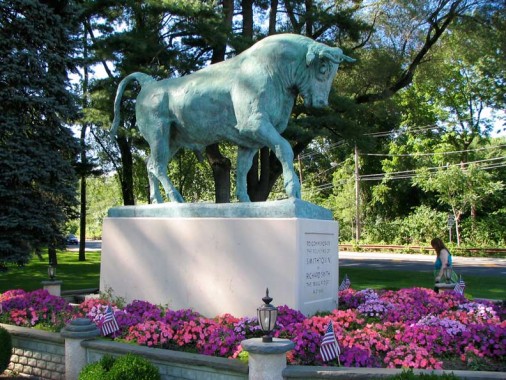Wall Street has been in the news for all the wrong reasons of late. Of course, one of its iconic images is Arturo Di Modica’s Charging Bull bronze sculpture at Bowling Green, a draw for tourists from all over the globe.
However, there is an even bigger bull in Smithtown, New York, a few miles east of town, that remembers a settler in the colonial era, Richard Smith, who founded the town in the 1600s.
The often repeated story about Smith, and one which apparently lacks historical foundation, recounts how he made an agreement with the Indians that he could have all of the land which he could encircle in one day riding on the back of a bull. From daylight to dusk he rode, so the legend goes, defining a huge domain. This story, whether true or not, left its mark upon the neighborhood; “Bread and Cheese Hollow” was so named, it is said, because Mr. Smith tarried there on the momentous ride for his noon-day meal.
The bronze statue of a bull (Charles Cary Rumsey, 1923), which was erected on a prominent corner of the village of Smithtown to commemorate Smith’s reputed exploit, has met with considerable disapproval throughout the years on the part of aesthetic- minded citizens. The principal part of Smithtown originally was owned by Lion Gardiner who received it from Grand Sachem Wyandanch in return for a noble service performed by the Englishman. Gardiner procured the ransom of the chief’s lovely daughter, Heather Flower, who had been captured on her wedding night by a raiding band of Narragansett Indians and carried off captive to Connecticut. Long Island Genealogy
The bull resided at the Brooklyn Museum for many years before its installation on Jericho Turnpike in 1941.
10/6/11
